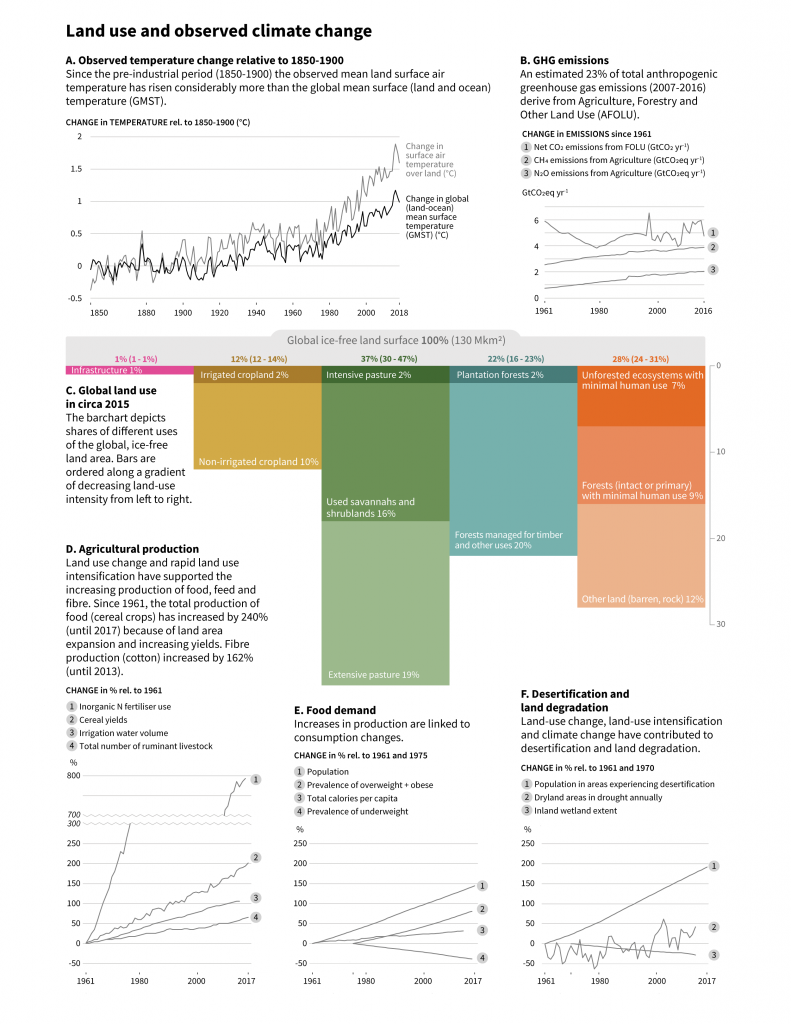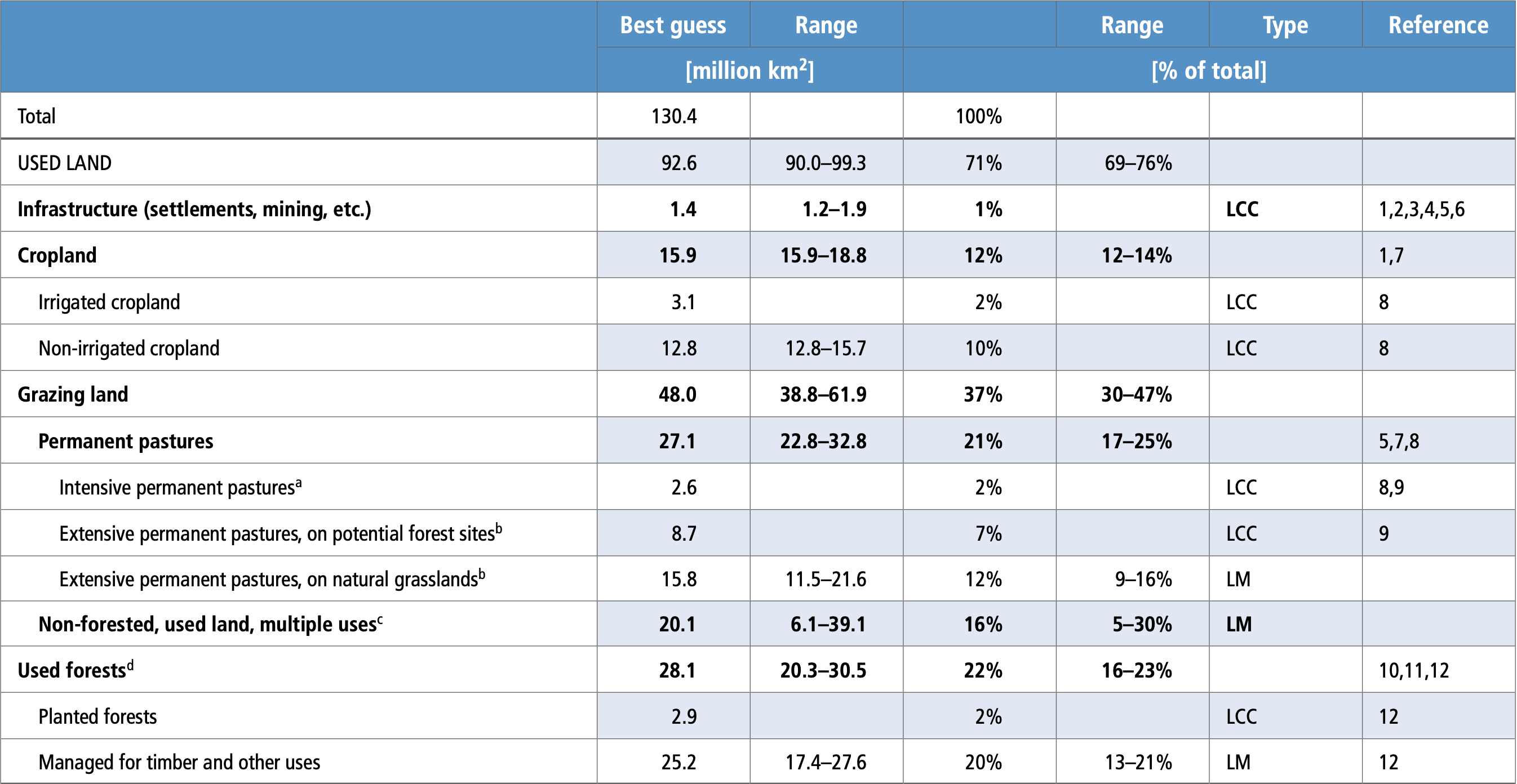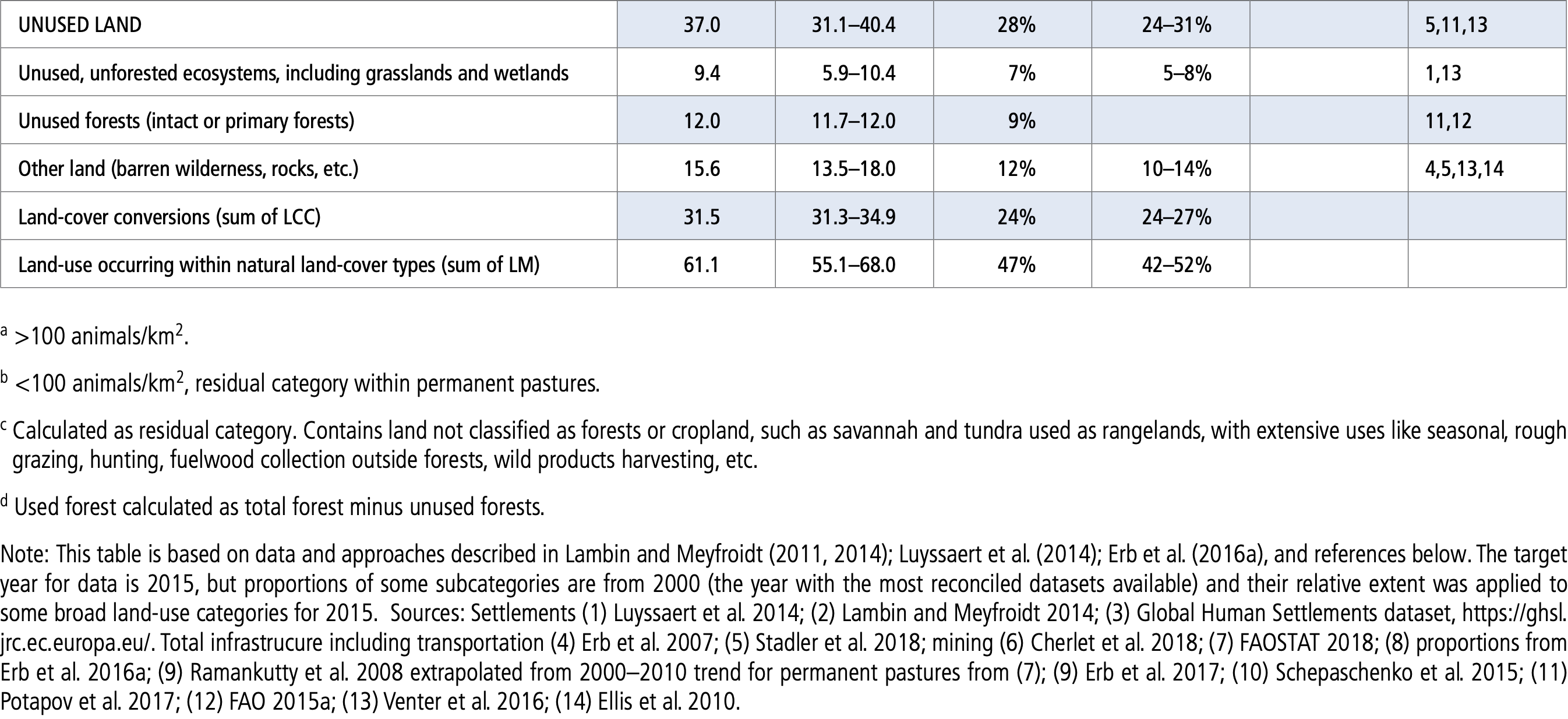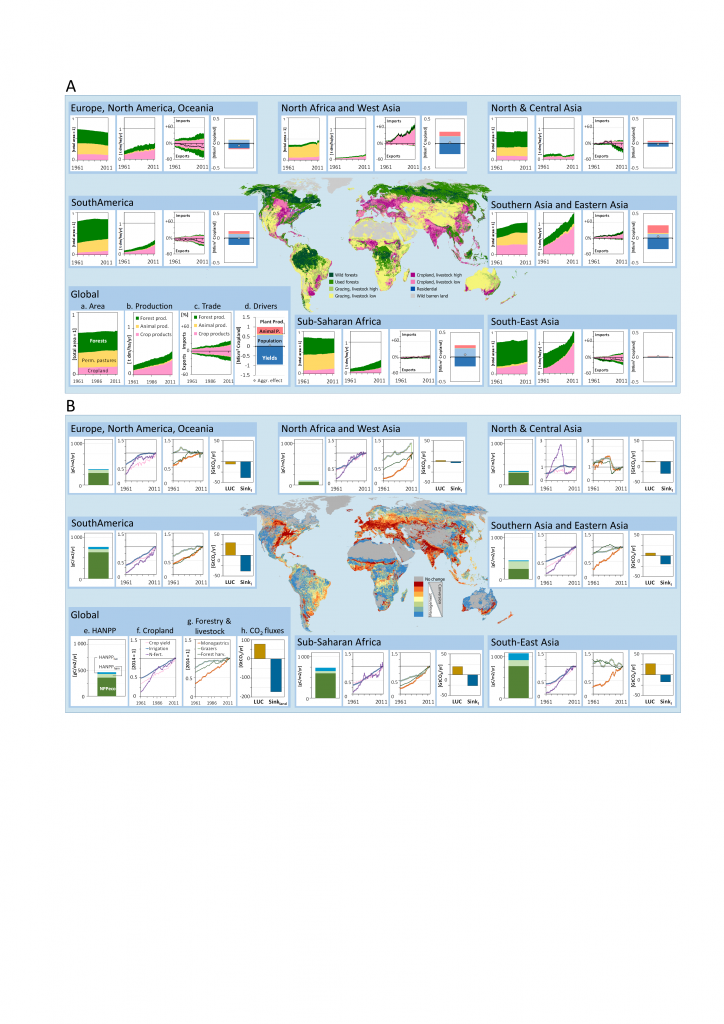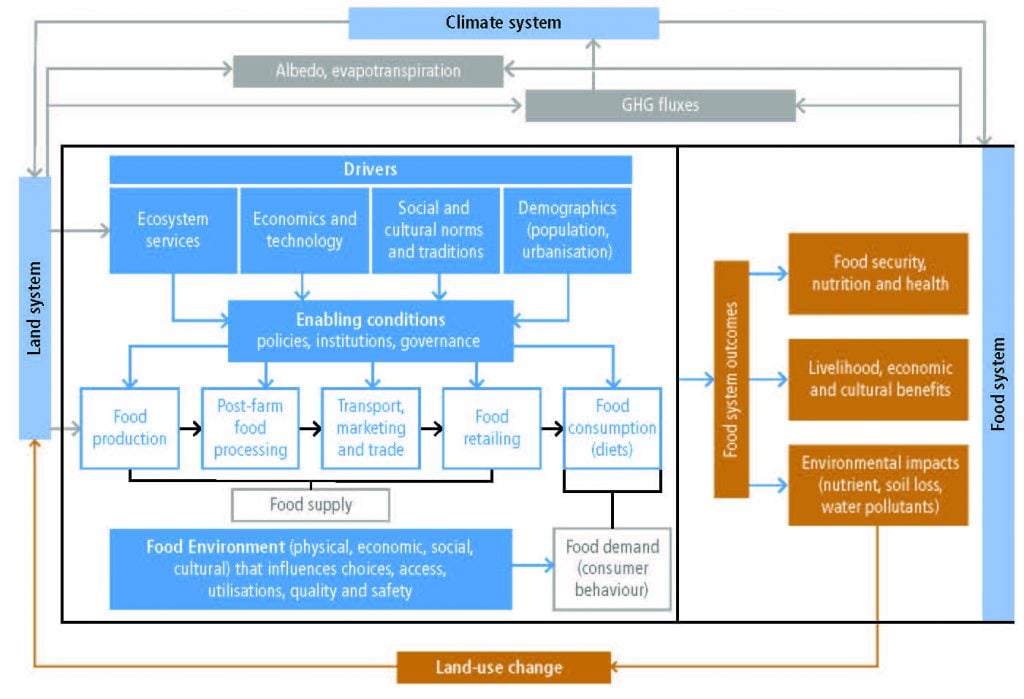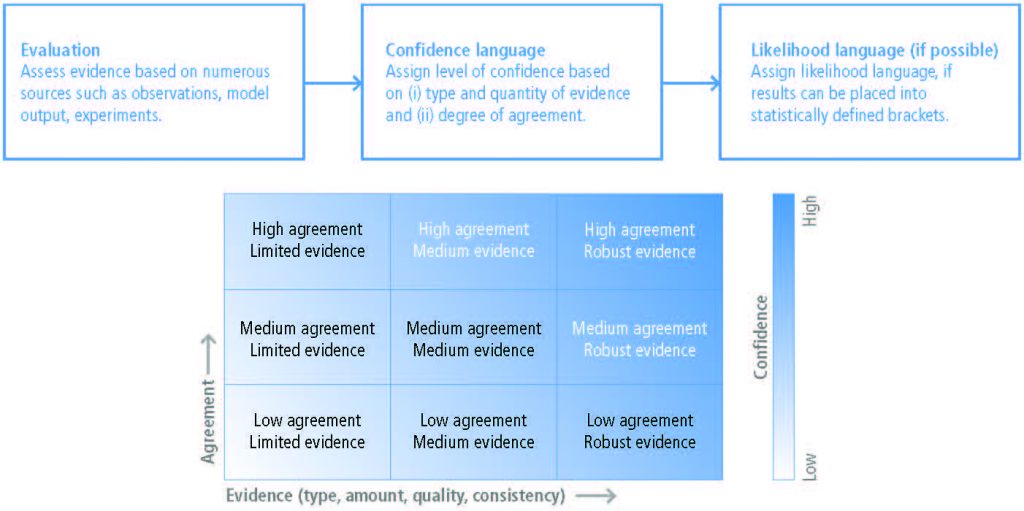ES
Executive Summary
Land, including its water bodies, provides the basis for human livelihoods and well-being through primary productivity, the supply of food, freshwater, and multiple other ecosystem services (high confidence). Neither our individual or societal identities, nor the world’s economy would exist without the multiple resources, services and livelihood systems provided by land ecosystems and biodiversity. The annual value of the world’s total terrestrial ecosystem services has been estimated at 75 trillion USD in 2011, approximately equivalent to the annual global Gross Domestic Product (based on USD2007 values) (medium confidence). Land and its biodiversity also represent essential, intangible benefits to humans, such as cognitive and spiritual enrichment, sense of belonging and aesthetic and recreational values. Valuing ecosystem services with monetary methods often overlooks these intangible services that shape societies, cultures and quality of life and the intrinsic value of biodiversity. The Earth’s land area is finite. Using land resources sustainably is fundamental for human well-being (high confidence). {1.1.1}
The current geographic spread of the use of land, the large appropriation of multiple ecosystem services and the loss of biodiversity are unprecedented in human history (high confidence). By 2015, about three-quarters of the global ice-free land surface was affected by human use. Humans appropriate one-quarter to one-third of global terrestrial potential net primary production (high confidence). Croplands cover 12–14% of the global ice-free surface. Since 1961, the supply of global per capita food calories increased by about one-third, with the consumption of vegetable oils and meat more than doubling. At the same time, the use of inorganic nitrogen fertiliser increased by nearly ninefold, and the use of irrigation water roughly doubled (high confidence). Human use, at varying intensities, affects about 60–85% of forests and 70–90% of other natural ecosystems (e.g., savannahs, natural grasslands) (high confidence). Land use caused global biodiversity to decrease by around 11–14% (medium confidence). {1.1.2}
Warming over land has occurred at a faster rate than the global mean and this has had observable impacts on the land system (high confidence). The average temperature over land for the period 2006–2015 was 1.53°C higher than for the period 1850–1900, and 0.66°C larger than the equivalent global mean temperature change. These warmer temperatures (with changing precipitation patterns) have altered the start and end of growing seasons, contributed to regional crop yield reductions, reduced freshwater availability, and put biodiversity under further stress and increased tree mortality (high confidence). Increasing levels of atmospheric CO2, have contributed to observed increases in plant growth as well as to increases in woody plant cover in grasslands and savannahs (medium confidence). {1.1.2}
Urgent action to stop and reverse the over-exploitation of land resources would buffer the negative impacts of multiple pressures, including climate change, on ecosystems and society (high confidence). Socio-economic drivers of land-use change such as technological development, population growth and increasing per capita demand for multiple ecosystem services are projected to continue into the future (high confidence). These and other drivers can amplify existing environmental and societal challenges, such as the conversion of natural ecosystems into managed land, rapid urbanisation, pollution from the intensification of land management and equitable access to land resources (high confidence). Climate change will add to these challenges through direct, negative impacts on ecosystems and the services they provide (high confidence). Acting immediately and simultaneously on these multiple drivers would enhance food, fibre and water security, alleviate desertification, and reverse land degradation, without compromising the non-material or regulating benefits from land (high confidence). {1.1.2, 1.2.1, 1.3.2–1.3.6, Cross-Chapter Box 1 in Chapter 1}
Rapid reductions in anthropogenic greenhouse gas (GHG) emissions that restrict warming to “well-below” 2°C would greatly reduce the negative impacts of climate change on land ecosystems (high confidence). In the absence of rapid emissions reductions, reliance on large-scale, land-based, climate change mitigation is projected to increase, which would aggravate existing pressures on land (high confidence). Climate change mitigation efforts that require large land areas (e.g., bioenergy and afforestation/reforestation) are projected to compete with existing uses of land (high confidence). The competition for land could increase food prices and lead to further intensification (e.g., fertiliser and water use) with implications for water and air pollution, and the further loss of biodiversity (medium confidence). Such consequences would jeopardise societies’ capacity to achieve many Sustainable Development Goals (SDGs) that depend on land (high confidence). {1.3.1, Cross-Chapter Box 2 in Chapter 1}
Nonetheless, there are many land-related climate change mitigation options that do not increase the competition for land (high confidence). Many of these options have co-benefits for climate change adaptation (medium confidence). Land use contributes about one-quarter of global greenhouse gas emissions, notably CO2 emissions from deforestation, CH4 emissions from rice and ruminant livestock and N2O emissions from fertiliser use (high confidence). Land ecosystems also take up large amounts of carbon (high confidence). Many land management options exist to both reduce the magnitude of emissions and enhance carbon uptake. These options enhance crop productivity, soil nutrient status, microclimate or biodiversity, and thus, support adaptation to climate change (high confidence). In addition, changes in consumer behaviour, such as reducing the over-consumption of food and energy would benefit the reduction of GHG emissions from land (high confidence). The barriers to the implementation of mitigation and adaptation options include skills deficit, financial and institutional barriers, absence of incentives, access to relevant technologies, consumer awareness and the limited spatial scale at which the success of these practices and methods have been demonstrated. {1.2.1, 1.3.2, 1.3.3, 1.3.4, 1.3.5, 1.3.6}
Sustainable food supply and food consumption, based on nutritionally balanced and diverse diets, would enhance food security under climate and socio-economic changes (high confidence). Improving food access, utilisation, quality and safety to enhance nutrition, and promoting globally equitable diets compatible with lower emissions have demonstrable positive impacts on land use and food security (high confidence). Food security is also negatively affected by food loss and waste (estimated as 25–30% of total food produced) (medium confidence). Barriers to improved food security include economic drivers (prices, availability and stability of supply) and traditional, social and cultural norms around food eating practices. Climate change is expected to increase variability in food production and prices globally (high confidence), but the trade in food commodities can buffer these effects. Trade can provide embodied flows of water, land and nutrients (medium confidence). Food trade can also have negative environmental impacts by displacing the effects of overconsumption (medium confidence). Future food systems and trade patterns will be shaped as much by policies as by economics (medium confidence). {1.2.1, 1.3.3}
A gender-inclusive approach offers opportunities to enhance the sustainable management of land (medium confidence). Women play a significant role in agriculture and rural economies globally. In many world regions, laws, cultural restrictions, patriarchy and social structures such as discriminatory customary laws and norms reduce women’s capacity in supporting the sustainable use of land resources (medium confidence). Therefore, acknowledging women’s land rights and bringing women’s land management knowledge into land-related decision-making would support the alleviation of land degradation, and facilitate the take-up of integrated adaptation and mitigation measures (medium confidence). {1.4.1, 1.4.2}
Regional and country specific contexts affect the capacity to respond to climate change and its impacts, through adaptation and mitigation (high confidence). There is large variability in the availability and use of land resources between regions, countries and land management systems. In addition, differences in socio-economic conditions, such as wealth, degree of industrialisation, institutions and governance, affect the capacity to respond to climate change, food insecurity, land degradation and desertification. The capacity to respond is also strongly affected by local land ownership. Hence, climate change will affect regions and communities differently (high confidence). {1.3, 1.4}
Cross-scale, cross-sectoral and inclusive governance can enable coordinated policy that supports effective adaptation and mitigation (high confidence). There is a lack of coordination across governance levels, for example, local, national, transboundary and international, in addressing climate change and sustainable land management challenges. Policy design and formulation is often strongly sectoral, which poses further barriers when integrating international decisions into relevant (sub)national policies. A portfolio of policy instruments that are inclusive of the diversity of governance actors would enable responses to complex land and climate challenges (high confidence). Inclusive governance that considers women’s and indigenous people’s rights to access and use land enhances the equitable sharing of land resources, fosters food security and increases the existing knowledge about land use, which can increase opportunities for adaptation and mitigation (medium confidence). {1.3.5, 1.4.1, 1.4.2, 1.4.3}
Scenarios and models are important tools to explore the trade-offs and co-benefits of land management decisions under uncertain futures (high confidence). Participatory, co-creation processes with stakeholders can facilitate the use of scenarios in designing future sustainable development strategies (medium confidence). In addition to qualitative approaches, models are critical in quantifying scenarios, but uncertainties in models arise from, for example, differences in baseline datasets, land cover classes and modelling paradigms (medium confidence). Current scenario approaches are limited in quantifying time-dependent policy and management decisions that can lead from today to desirable futures or visions. Advances in scenario analysis and modelling are needed to better account for full environmental costs and non-monetary values as part of human decision-making processes. {1.2.2, Cross-Chapter Box 1 in Chapter 1}

